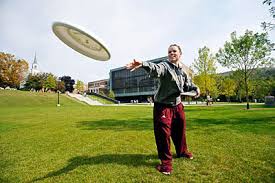It can be difficult to create an interesting math problem that engages students. One way to grab students’ attention right from the start is to incorporate a relatable picture into the math problem. For instance, the picture above. Many math problems can be inspired by this image, but one problem in particular is a trigonometry problem involving a right triangle created from throwing the Frisbee.
An example of this problem could be:
Imagine you are throwing a Frisbee to a friend. If you throw the Frisbee linearly, at a 12-degree angle, and the Frisbee is 10ft. directly above your friend’s head, how far away are you from your friend?
For this problem, students would be using their problem solving skills and the concept of trigonometry, to relate the given side lengths and degrees. The students will have to go through the process of creating a diagram or visual of the triangle being discussed, decide how the picture will look, and where the information should be placed. Once the diagram is complete, students must have the right angle placed at the friend, with the 10ft. marked as the leg above that friend, and the 12-degree angle placed at the student. After this, the student must use algebra to complete the problem and find the distance between the student and their friend. Therefore, this problem is comparable to any simple trigonometry problem. However, if the students begin by looking at this picture and imagining doing the activity of throwing a Frisbee to their friend, then the problem will become much more engaging and relatable.
The Common Core State Standard that this problem teaches is:
Understand that by similarity, side ratios in right triangles are properties of the angles in the triangle, leading to definitions of trigonometric ratios for acute angles.

Nice idea! With frisbees, you could also give them a table of data where they have the x and y coordinates, specifically making the vertex in it, and create a quadratic model of the frisbees flight path. Then as a little harder thought, have them conjecture as to why the model seems to be affected by gravity less than a normal object that is falling. This would follow CCSS.MATH.CONTENT.HSF.LE.A.3
Observe using graphs and tables that a quantity increasing exponentially eventually exceeds a quantity increasing linearly, quadratically, or (more generally) as a polynomial function.